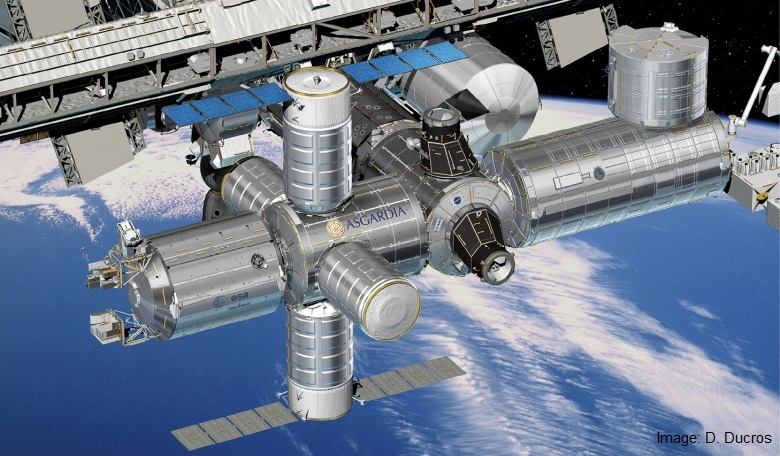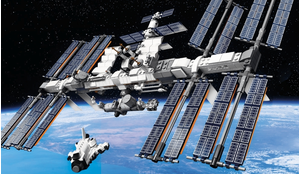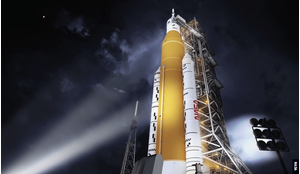Private sector involvement in the International Space Station (ISS) is becoming increasingly important as commercial organisations provide services and hardware to enhance the orbital operations of the Space Station which, in November 2020, marked two decades of continuous occupation. During the first Asgardia Space Science & Investment Conference, held in Germany in October 2019, a project to add a new commercially procured docking module to the ISS was announced as a key step to expanding the permanent human presence in low Earth orbit. Dr Igor Ashurbeyli, General Designer, provides a technical overview of the project and the industrial partnership arranged to deliver it.
Over the past decade, the International Space Station partnership has continually addressed the future of research in - and exploitation of - low Earth orbit (LEO) beyond the lifetime of the ISS. At present, it seems likely that the Space Station will remain in operation until about 2030, but it is clear that it cannot last forever in its current form.
NASA, as the leading partner in the ISS, took the initiative to devise a commercialisation plan for utilisation of the ISS that would transfer some of the responsibility for operations and services to the private sector. Announced in June 2019, the plan incorporated five main pillars: the establishment of an ISS commercial use and pricing policy; the introduction of private astronaut missions; the initiation of processes for commercial development of LEO; the pursuit of opportunities to stimulate sustainable demand; and the quantification of the Agency’s long-term needs for activities in LEO.

As a result, the US National Laboratory, which manages the utilisation of the American segment of the Space Station, has seen private investment for the expansion of ISS facilities, from small laboratory equipment to large structural components. Meanwhile, almost all the other ISS partners have developed new policies to expand the utilisation of the ISS and its facilities to outside parties, commercial companies and countries beyond the five partner agencies.
Importantly, these new commercial policies are not limited to the provision of uncrewed infrastructure and hardware, but focus on enabling new avenues of access for private astronauts. This is of interest to nations that have not traditionally had access to human space exploration, as shown by the inauguration of the United Arab Emirates astronaut programme and other initiatives such as the Indian, Turkish and Nigerian spaceflight programmes.
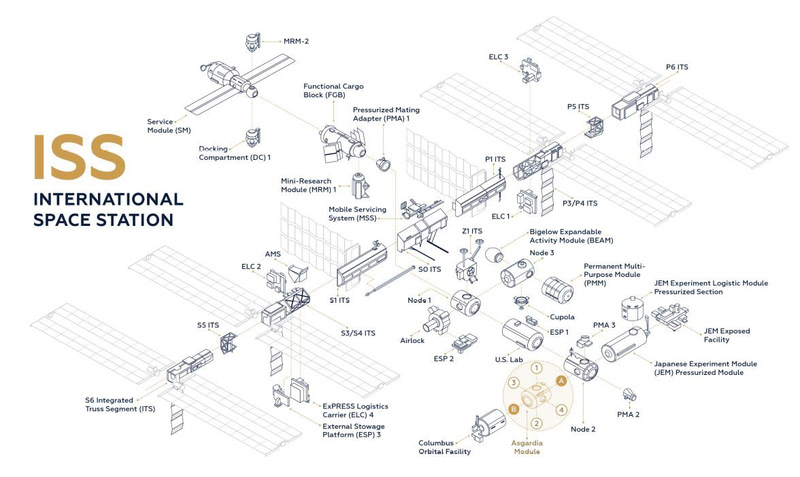 Proposed position of the Asgardia node module in the overall ISS architecture.
Proposed position of the Asgardia node module in the overall ISS architecture.
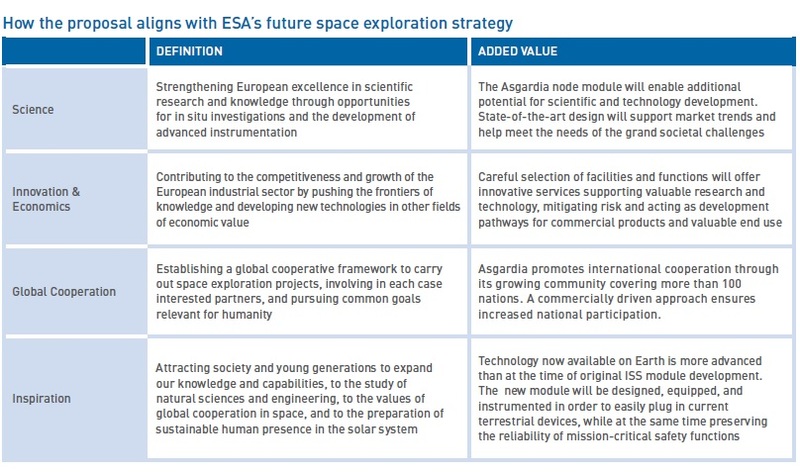
ISS commercialisation
The current, standard ISS design supports crews of up to six, so any planned increase in crew numbers will require additional facilities
The current, standard ISS design supports crews of up to seven, so any planned increase in crew numbers will require additional facilities for science and research, and more diversified habitation spaces for work, sleep, hygiene, nutrition, entertainment, etc. And, naturally, this will require an increase in the capacity of life support systems.
The most significant examples of commercial efforts to augment the ISS include the Bigelow expandable module and the upcoming Bartolomeo facility by Airbus and Bishop Airlock from Nanoracks. Most recently, in January 2020, NASA awarded a US$140 million contract to Axiom to build a habitable commercial module to be attached to the ISS from 2024. These developments make it clear that NASA is rising to the challenge of commercialising the ISS, not least because the Agency recognises that this allows it to redirect funding towards other, more demanding projects such as Moon-Mars exploration.
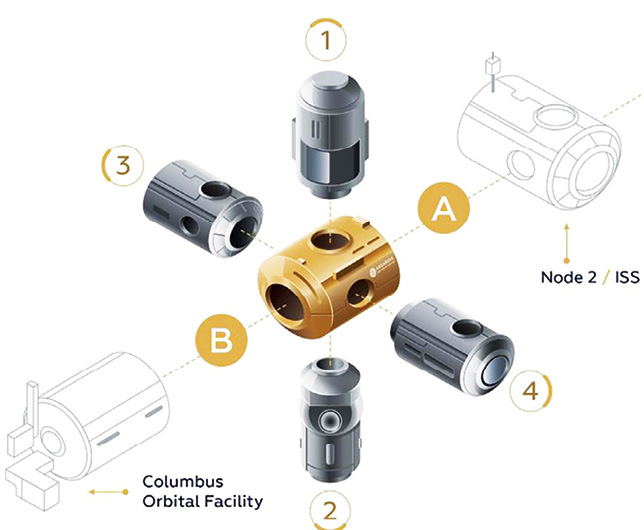 Asgardia node module enables an ISS evolutionary scenario.
Asgardia node module enables an ISS evolutionary scenario.
While these examples highlight the case for commercialisation, they also focus attention on the current constraints of the ISS, specifically the limited number of nodes and access ports available. These ports are the key enabling capability required to expand the ISS, both temporarily and permanently.
Indeed, it is the number of available docking ports and related infrastructure that constitutes the major obstacle to the expansion of commercial capabilities on the ISS. To directly address this obstacle, Asgardia has proposed the provision of an ‘Asgardia Node Module’ that would be integrated into the European part of the ISS.
Asgardia Module
The proposal for a new ISS module was submitted in response to a European Space Agency (ESA) Call for Ideas entitled, ‘Space exploration as a driver for growth and competitiveness: opportunities for the private sector’. As such, it addressed the limitations in habitable volume and research capabilities and incorporated the much-needed additional docking ports, which would be made available to both institutional and commercial customers.
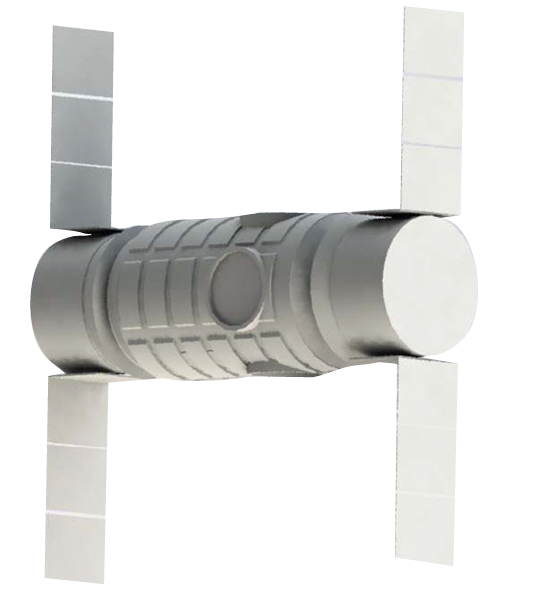 Possible additional configuration of Asgardia node module in flight configuration, with two service modules attached to further increase its autonomy after the ISS lifetime.
Possible additional configuration of Asgardia node module in flight configuration, with two service modules attached to further increase its autonomy after the ISS lifetime.
Moreover, the project is very much in line with the goals of ESA’s space exploration strategy, which was adopted in 2014 with four strategic goals: scientific advancement; innovation and economic growth; global cooperation; and inspiration. Indeed, the project was designed to capture investment from around the world, while providing jobs for European industry and offering a path to take European independence in space to a new level.
Available docking ports and related infrastructure constitute a major obstacle to the expansion of commercial capabilities on the ISS
In addition, the proposal recognises the eventual demise of the existing ISS project and offers the beginnings of a ‘roadmap to the future’ for the development of the much-touted ‘low Earth orbit economy’. Despite the hype, such proposals are otherwise conspicuous by their absence.
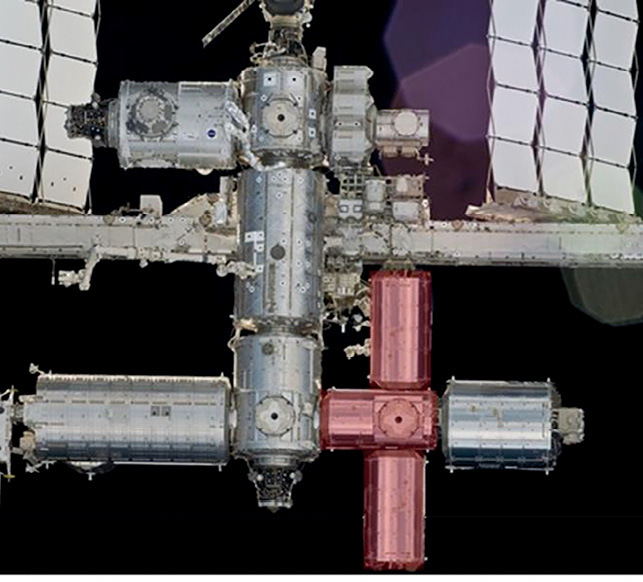 A new docking module has the potential to significantly enhance ISS operations (perspective from below the ISS).
A new docking module has the potential to significantly enhance ISS operations (perspective from below the ISS).
The essence of the Asgardia initiative is the construction of a LEO economy with industrial, commercial and institutional partners, in which space agencies will be one of many customers. In addition, it supports the long-term goal of Asgardia to establish an autonomous space infrastructure in LEO - known as ‘Asgardia Earth Ark’ - to enable continuous development and research beyond the operational lifetime of the ISS.
Specifically, the proposal explores the development of a ‘node module’ based on existing orbital infrastructure developed by the European space industry, and commercially funded as part of a public-private partnership (PPP) between commercial organisations and the European Space Agency.
At a minimum, the Asgardia node module will:
- provide additional docking ports and thus the opportunity to integrate commercial modules from new participants
- expand the habitable volume of the ISS, and the volume available for stowage and research, both for ESA and commercial partners
- provide new facilities to meet the needs of European high-tech industries
- enable innovative forms of international and commercial partnerships.
 Roles and contributions of key partners
Roles and contributions of key partners
Analysis of the possible options showed that the most optimal and technically feasible solution is a node module based substantially on the design and on-board systems of the ISS modules that have already been developed. This standardised, heritage design also allows for the creation of a series of inhabited modules for various projects and customers at a reduced cost of manufacturing, coupled with the advantage of the ability to use standard commercially available launch vehicles.
The project is very much in line with the goals of ESA’s space exploration strategy
Apart from providing additional docking ports, the configuration will meet all the requirements for continued operation of the Columbus module, which is currently docked to the starboard docking port of ISS Node 2. The technical feasibility study, which marks the next phase of the project, would focus on the insertion of the Asgardia node module between Node 2 starboard and Columbus, a configuration that best enables the expansion of docking facilities for third party customers.
The assembly sequence currently
envisaged includes:
- the deactivation of the Columbus module and its temporary relocation to a different berthing port
- the capture and berthing of the ‘Asgardia’ node to Node 2 starboard port, and its activation
- the relocation of Columbus to the Asgardia node starboard berthing port, and its reactivation.
A detailed assembly and integration sequence would be defined and agreed among the parties involved after signature of a Memorandum of Understanding (MoU).
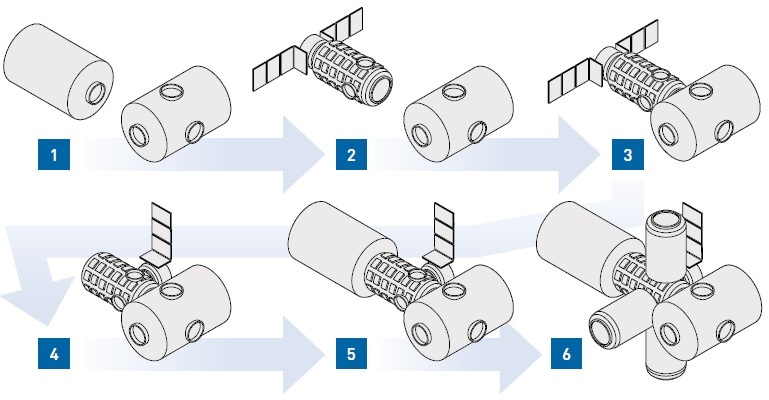 Assembly scenario.
Assembly scenario.
The initial set of functions and capabilities provided by the Asgardia node module are:
- a pressurised compartment with environmental conditions (atmosphere, humidity, temperature, etc) in accordance with accepted ISS standards
- autonomous power generation and
heat rejection - resource distribution to attached elements (power, data, comms, thermal, etc)
- docking ports for visiting vehicles
- accommodation of payload facilities
and experiments - ergonomic requirements for a crew of up to two.
The proposal recognises the eventual demise of the existing ISS project and offers the beginnings of a ‘roadmap to the future’
In addition, the Asgardia node will provide functions for autonomous flight, including rendezvous and docking, which will be crucial for the time when, following the ISS end of life, the Asgardia node module will function as the core element of the proposed Asgardia Earth Ark.
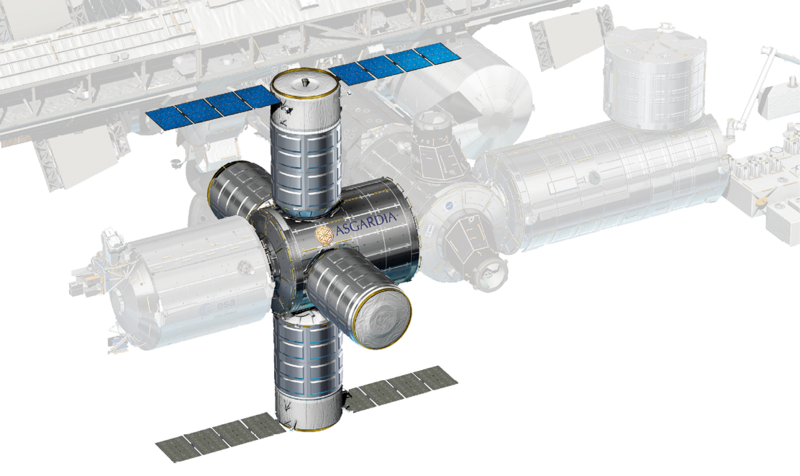 The Asgardia node with two service modules and four additional modules (highlighted) - elements that could form the basis of the space nation’s future Earth Ark.
The Asgardia node with two service modules and four additional modules (highlighted) - elements that could form the basis of the space nation’s future Earth Ark.
Consortium
The consortium behind this initiative is led by Asgardia and includes Nanoracks-Europe, Thales Alenia Space (Italy), OHB (Germany) and QinetiQ (Belgium) – see Table on page 49.
Asgardia will be the owner of the infrastructure and will secure funding. As the initiating partner, Asgardia appointed Nanoracks-Europe as the implementing coordinator to engage industrial partners and support relations with ESA and other stakeholders for the advancement of the project. Thales Alenia Space (TAS-Italia) is the lead industrial partner, responsible for system engineering and the habitat module; OHB (Germany) is responsible for subsystems and facilities development; and QinetiQ (UK) is responsible for the International Berthing and Docking Mechanism (IBDM). The Asgardia Independent Research Center (AIRC) is an industrial partner for research and is responsible for control systems.
A detailed definition of the tasks between the partners would be finalised during the pilot phase of the project, following signature of the MoU, when all technical, programmatic and financial aspects would be addressed. The development, manufacturing and deployment phase is expected to take about five years with a possible launch in 2026.
As part of the proposal submitted to ESA in response to its Call for Ideas, Asgardia detailed its plans to design, manufacture, launch and deliver the Asgardia node module to the ISS, engage the public and the business community and, crucially, provide the main funding for the implementation of the project by attracting external investment.
The essence of the Asgardia initiative is the construction of a LEO economy
The aim of the consortium is to secure funding through private sector investments and pre-development service sales (for example, for facility time-sharing and astronaut access to the node module). In return, Asgardia asked ESA to provide the interface with all the international partners (particularly NASA and other ISS partners), access to docking ports and interfaces on the European part of the ISS, and other resources such as crew time and technical consultancy.
Unfortunately, despite recognising its technical validity and potential promise, ESA has for now declined the consortium’s visionary proposal due to “political and technological risks”.
Project potential
In conclusion, I would like to emphasise the following: as a digital space nation Asgardia is not yet formally recognised by earthly states and so politcial risks are zero; technological risks are also minimal given that the consortium members are space industry world leaders and are committed to the project to design and build the Asgardia node and deliver it to the ISS; and, at the same time, Asgardia remains confident that the financial resources for the project can be found in the marketplace.
Within this context, a significant effort has to be made to make the partnership effective, both to service space agency requirements and to meet the expectations of Asgardia’s vision.
Indeed, a number of positive potential impacts have been identified under two main category headings. The first impact category, known as ‘GDP impact’, concerns the effect of private investment in the development and manufacturing of the Asgardia node module on the economy, in that private investment is expected to lead to an increase in economic activity throughout the supply chain.
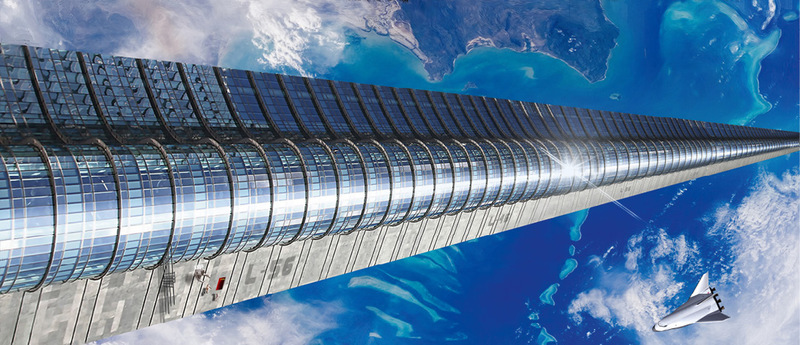 Orbital infrastructures of today like the ISS are the precursor to much larger and long-term endeavours of the future.
Orbital infrastructures of today like the ISS are the precursor to much larger and long-term endeavours of the future.
Although the project commenced before the onset of the Covid-19 pandemic, the potential of the project to secure and maintain employment within the European space industry cannot be ignored.
The compound effect of this investment in industry, estimated in terms of ‘gross value added’ (GVA) constitutes the GDP impact. The second impact, known as ‘catalytic impact’, corresponds to economic activities enabled by the infrastructure (in this case the node-module) and relates to gross revenues resulting directly from the sale of services.
Following ISS end of life, the Asgardia node module will function as the core element of the proposed Asgardia Earth Ark
Other quantitative and qualitative impacts include impacts on European space industry competitiveness, on the non-space economy, and wider, strategic impacts such as secured employment, industry commercial positioning and enlargement of ISS objectives.
Asgardia was motivated to establish this partnership not only by the obvious need to maintain an in-orbit infrastructure as a follow-on to the ISS, but also by the need to modernise the European part of the ISS and support programmes for the exploration of the Moon and Mars.
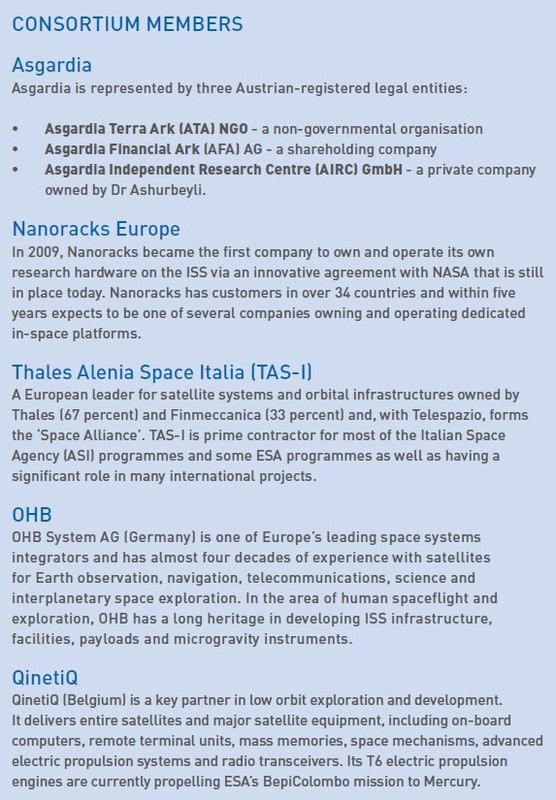
Indeed, the main goal of the proposed partnership remains. Asgardia believes that it is necessary to combine efforts and competencies, and of course share risks, to ensure the continued development of the orbital infrastructure of the European community in the interests of all humankind.
About the author
Dr Igor Ashurbeyli, a Russian scientist, businessman and philanthropist, is the Founder of Asgardia. He has a Doctorate of Science in Engineering with a specialisation in Automated Control Systems for aerospace applications. In 1988, he founded Socium Holding which now has approximately 9,000 employees at over 30 companies, where he is still Chairman of the Board and a beneficiary. From 2000 to 2010, Dr Ashurbeyli was the CEO of the Almaz Central Design Bureau, the lead developer of air-defence systems for the USSR and later the Russian Federation. In 2010 he was awarded the State Science & Technology Prize of Russia for his achievements in science and technology. In 2013 Dr Ashurbeyli founded the Asgardia Independent Research Center (AIRC) in Vienna, Austria, and the following year the Center began publication of the international space journal, ROOM. In 2016, he was awarded a Gold UNESCO Medal ‘For contribution to the development of nanoscience and nanotechnologies’. In March 2017, Dr Ashurbeyli founded Asgardia Terra Ark (ATA) NGO, representing the digital space nation Asgardia on Earth.





